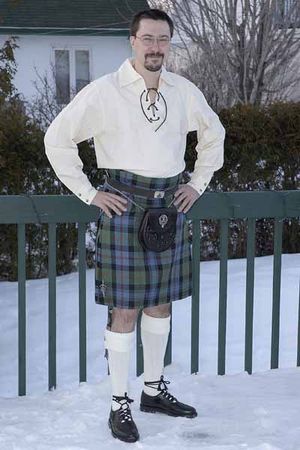Tartan
Tartan (Irish: breacán) is a patterned cloth consisting of crisscrossed, horizontal and vertical bands in multiple colors. Tartans originated in woven wool, but now they are made in many other materials. Scottish tartans usually represent a clan whilst Irish tartans usually represent the county or region where a clan originated.
Tartan is made with alternating bands of colored (pre-dyed) threads woven as both warp and weft at right angles to each other. The weft is woven in a simple twill, two over—two under the warp, advancing one thread at each pass. This forms visible diagonal lines where different colors cross, which gives the appearance of new colors blended from the original ones. The resulting blocks of color repeat vertically and horizontally in a distinctive pattern of squares and lines known as a sett. Tartan is often called "plaid" (particularly in North America), but in Scotland, a plaid is a large piece of tartan cloth, worn as a type of kilt or large shawl. The term plaid is also used in Scotland for an ordinary blanket such as one would have on a bed.
The Dress Act of 1746 attempted to bring the warrior clans under government control by banning the tartan and other aspects of Gaelic culture. When the law was repealed in 1782, it was no longer an ordinary Highland dress but was adopted instead as the symbolic national dress of Scotland, a status that was widely popularised after King George IV wore a tartan kilt in his 1822 visit to Scotland. Until the middle of the nineteenth century, the highland tartans were only associated with either regions or districts, rather than any specific Scottish clan. This was because like other materials, tartan designs were produced by local weavers for local tastes and would usually only use the natural dyes available in that area, as synthetic dye production was non-existent and transportation of other dye materials across long distances was prohibitively expensive. The patterns were simply different regional checked-cloth patterns, chosen by the wearer's preference—in the same way as people nowadays choose what colors and patterns they like in their clothing, without particular reference to propriety. It was not until the mid-nineteenth century that many patterns were created and artificially associated with Scottish clans, families, or institutions who were (or wished to be seen as) associated in some way with a Scottish heritage. The Victorians' penchant for ordered taxonomy and the new chemical dyes then available meant that the idea of specific patterns of bright colors, or "dress" tartans, could be created and applied to a nostalgic view of Scottish history.
Today tartan is no longer limited to textiles but is also used as a name for the pattern itself, appearing on media such as paper, plastics, packaging, and wall coverings.
| Portal:Clothing articles |
|---|
|
Chat rooms • What links here • Copyright info • Contact information • Category:Root
